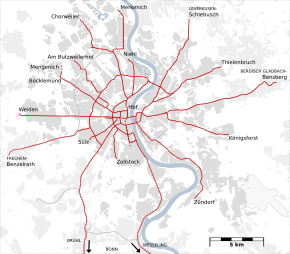
Back Městská dráha v Kolíně nad Rýnem Czech Stadtbahn Köln German Stadtbahn de Kolonjo Esperanto Koloniako tranbia Basque قطار شهری کلن Persian Métro léger de Cologne French Kölni Stadtbahn Hungarian Stadtbahn di Köln IO Stadtbahn di Colonia Italian ケルンLRT Japanese
| Cologne Stadtbahn | |||
|---|---|---|---|
 KVB logo | |||
 Light rail trainset in front of the river Rhine and Cologne Cathedral | |||
| Overview | |||
| Owner | Kölner Verkehrs-Betriebe | ||
| Locale | Cologne (Köln) Germany | ||
| Transit type | Light rail (Stadtbahn) | ||
| Number of lines | 12 | ||
| Number of stations | 236 | ||
| Daily ridership | 594,520 (2019)[1] | ||
| Annual ridership | 217,000,000 (2019)[1] | ||
| Website | www.kvb.koeln | ||
| Operation | |||
| Began operation | |||
| Operator(s) | Kölner Verkehrs-Betriebe (KVB) | ||
| Number of vehicles | 382 (2019)[1] | ||
| Train length | 60 m (196.85 ft) | ||
| Technical | |||
| System length | 198.5 km (123.3 mi) (2019)[1] | ||
| Track gauge | 1,435 mm (4 ft 8+1⁄2 in) standard gauge | ||
| Electrification | Overhead line, 750 V DC[4] | ||
| Average speed | 25.9 km/h (16.1 mph) (2019)[1] | ||
| |||
The Cologne Stadtbahn is a light rail system in the German city of Cologne, including several surrounding cities of the Cologne Bonn Region (Bergisch Gladbach, Bonn, Bornheim, Brühl, Frechen, Hürth, Leverkusen-Schlebusch, Wesseling). The term Stadtbahn denotes a system that encompasses elements of trams as well as an underground railway network (U-Bahn) and interurban rail, even including three lines that are licensed as heavy rail and used by freight trains as well as Stadtbahn vehicles. Two of these lines connect the Cologne Stadtbahn to the Bonn Stadtbahn. These lines (16 and 18) are jointly operated by both cities' transport authorities, resulting in both systems and the lines connecting them sometimes collectively referred to as Stadtbahn Rhein-Sieg.
The Cologne Stadtbahn is operated by the Kölner Verkehrsbetriebe (KVB) and the Bonn Stadtbahn is operated by the Stadtwerke Bonn (SWB – City of Bonn Utilities Division). The KVB and SWB are members of the Verkehrsverbund Rhein-Sieg (VRS – Rhein-Sieg Transit Authority), formed in 1987 to consolidate the transit authorities in the metropolitan Cologne area and operate a joint fare structure.[5][6] There are 236 stations along 199 km (124 mi) of tracks,[7] of which 42 are underground in 28 km (17 mi) of tunnels.
- ^ a b c d e "Kölner Verkehrs-Betriebe AG". kvb.koeln. Archived from the original on 18 June 2022. Retrieved 4 July 2022.
- ^ "KVB-Geschichte von 1877 bis 1949" (in German). kvb.koeln. Archived from the original on 7 May 2021. Retrieved 4 July 2022.
- ^ "KVB-Geschichte von 1950 bis 1984" [KVB-History from 1950 to 1984]. kvb.koeln (in German). Archived from the original on 7 May 2021. Retrieved 6 July 2022.
- ^ Zeidler-Goll, Susanne (23 February 2016). "Wie kommt der Strom in die Bahn?" (in German). Archived from the original on 18 January 2022. Retrieved 4 July 2022.
- ^ "Wir fahren Sie..." [We transport you...]. VRS (in German). Archived from the original on 12 June 2020. Retrieved 6 May 2020.
- ^ Cite error: The named reference
history 1985was invoked but never defined (see the help page). - ^ "KVB Geschäftsbericht 2021". Kölner Verkehrs-Betriebe AG (in German). June 2022. Archived from the original on 9 August 2022. Retrieved 9 August 2022.
